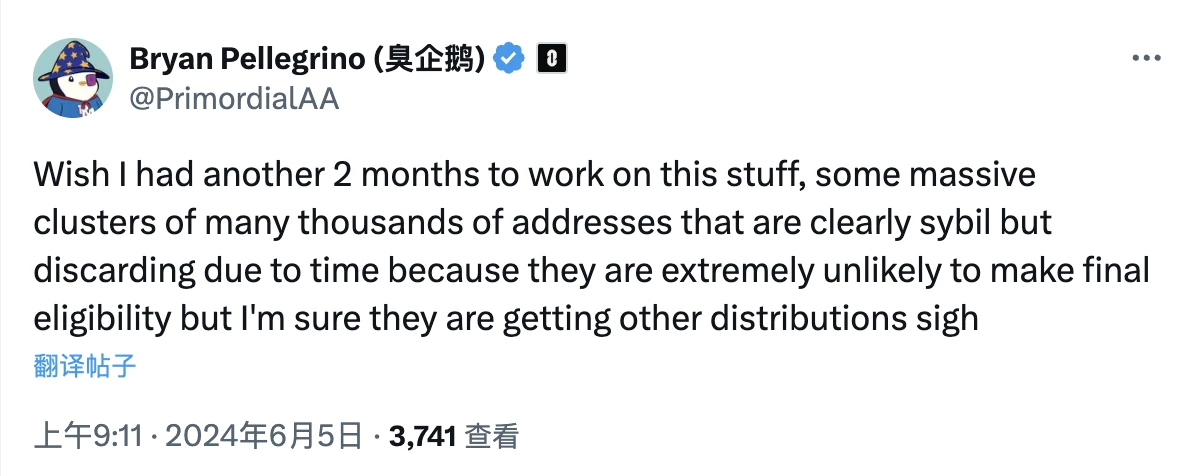Original | Odaily Planet Daily
Author | Azuma

The largest witch purge in history, organized by LayerZero, has officially concluded.
Over the past month, LayerZeros every move has always attracted the attention of the community, from calling on witches to expose themselves in order to retain a 15% airdrop share, to the official joint screening with data analysis agencies such as Chaos Labs and Nansen, to encouraging hunters to actively report through a 10% share reward and mobilizing the masses to fight the masses.
Especially the last reporting link, although this is not the original creation of LayerZero (Hop Protocol and others have also had this design before), as one of the most watched potential airdrop projects in the market, the waves caused by LayerZero this time are far greater than those of its predecessors . Driven by interests, countless hunters submitted thousands of witch reports to LayerZero, forcing Github to use account bans to relieve server pressure. Even after the event was migrated to Commonwealth and a 0.5 ETH margin requirement was added, hunters still submitted more than 3,000 witch reports in a short three-day window.
Judging from the results alone, LayerZero seems to have gotten what it wanted in this event that mobilized the entire community - it obtained a large amount of data samples, which can be used as a basis to adjust the airdrop rules - but judging from the feedback from the community, the controversy and doubts surrounding this event have never dissipated. From the rationality of the reports submitted by the hunters, to whether professional institutions will become hunters to hunt, to whether LayerZero can balance efficiency and fairness as an audit referee, and whether the final witch list will be reused by later projects, and even the far-reaching impact of this model on the airdrop paradigm, many problems in the market have not been effectively answered.
To this end, Odaily Planet Daily contacted Trusta Labs, hoping to find answers to these questions from a more professional perspective. As a Web3 re-startup project of the former anti-fraud team of a large company, Trusta Labs has rapidly risen in the past year with its strong data analysis capabilities and accurate human insight capabilities. It provides professional airdrop design services and on-chain AI data analysis services on the B-side, and has personally undertaken the airdrop rule design of many leading projects such as Celestia, Starknet, and Manta. On the C-side, it provides quantitative standards for on-chain value assessment through the on-chain scoring standard MEDIA Score, helping users to more clearly grasp their own address behavior, and gradually becoming one of the most watched and most topical professional institutions in the airdrop field.
LayerZero conducted a massive social experiment, but what were the results?
Looking back at the development history of airdrop design, it is essentially a dynamic game between project owners and users (including witches). Since the classic airdrop of Uniswap, the projects that have successively ushered in TGE have been painstakingly and skillfully in the design of rules, until todays high-profile LayerZero. Overall, the project owners have been increasing their efforts to fight against witches.
Trusta Labs believes that the fundamental reason is that with the influx of more and more users (including witches), the airdrop market has become more people than porridge and is still intensifying. There is a mismatch between the high expectations of users and the chips that the project parties can provide. Based on this trend, the later project parties have to choose to increase their efforts to fight against witches, snatch food from the mouths of witches, and then compete for more chips for normal users recognized by the project parties.
This is especially true for projects like LayerZero, which have millions of interactive addresses. However, LayerZero did not choose to entrust a professional organization to design the airdrop like earlier leading projects such as Arbitrum and Starknet. Instead, it personally launched this large-scale social experiment that took nearly a month, attempting to use it to conduct a more thorough siege of witches.
However, in the view of Trusta Labs, LayerZeros experiment had certain problems in both planning and execution , which is also the fundamental reason why the community reacted so strongly.
From a planning perspective, the biggest problem is that LayerZero failed to clarify the token economic model and airdrop share planning in advance. In short, no one knows how much airdrop will be issued? Which addresses are eligible? The so-called self-exposure can retain 15% of the original share, and reporting can get 10%, but no one knows how much the original share is; there are no specific rules for how the deducted tokens will be distributed... Opacity means there is room for manipulation, which is difficult to convince the community.
As for the execution level, the effectiveness of the three major links, namely self-disclosure, screening and reporting, is also questionable.
First, the self-disclosure link. Trusta Labs believes that this form is actually difficult to play a big role , because the addresses that choose to self-disclose generally do not get too many shares, and the impact on the overall chip distribution is relatively small. In retrospect, the proportion of addresses that choose to self-disclose is not high. In addition, LayerZeros original intention is to improve the screening mechanism by using the behavioral logic of self-disclosure addresses, but because the addresses that choose to self-disclose are relatively scattered, and witches generally appear in clusters with the same behavioral logic, it is difficult to obtain a unified logic through scattered samples.
Next came the official screening phase. LayerZero commissioned Chaos Labs and Nansen to conduct a Sybil logic analysis. However, after the list was released, a large number of users reported that their unique addresses were marked as Sybils. LayerZero had to open an appeal channel for secondary inspection afterwards. In this regard, Trusta Labs inferred that LayerZero may have included too many low-share addresses in the sample selection, resulting in a deviation in the model and a certain logical omission in Sybil identification.
The biggest problem comes from the reporting process. LayerZeros original intention of actively mobilizing the community may be to reduce the workload and improve efficiency by collective wisdom, but in fact LayerZero ultimately needs to check more than 3,000 reports one by one to screen out valid reports with logical validity. This has become a more time-consuming and laborious task. If a rough screening is done, it is easy to cause omissions; if a detailed screening is done, a lot of manpower and time costs are required. In fact, even LayerZero founder Bryan Pellegrino himself once lamented that he hoped to have more time to deal with these things. In addition, due to certain malicious reports, list plagiarism, address poisoning and other behaviors in the reporting process, the evil side of human nature has been fully exposed, and the dissatisfaction of the community has been gradually pushed up.

Odaily Note: Pellegrino lamented in a post on X that he hoped to have another two months to conduct a detailed inspection.
In summary, LayerZero launched an unprecedented witch cleansing experiment in the industry. This courage and hard work are worthy of praise, but in retrospect, there may still be a lot of room for improvement in the planning and execution of this experiment.
LayerZero plants trees, and zkSync enjoys the shade?
After the LayerZero experiment ended, someone asked, after a month of hard work, the team wasted a lot of time and energy, and the community was exhausted, who is the real beneficiary?
In response to this question, Trusta Labs gave a slightly unexpected answer - zkSync... In the view of Trusta Labs, the greatest achievement of LayerZeros experiment is the final list of witches, and later projects can get a bargain for free, while the communitys noise will only focus on LayerZero.
Trusta Labs predicts that those projects with TGE plans in the coming period may choose to wait for LayerZeros specific list and then check it against their own screening rules. For example, zkSync, another major airdrop project that has received a lot of attention recently, can use LayerZero s list to implement strict Sybil screening in a relatively gentle way, thereby avoiding stirring up community sentiment again after the trademark issue caused public outrage.
As for whether LayerZero’s three-layer cleansing model will become a new paradigm for airdrops in the future, Trusta Labs does not think so.
From the perspective of the project, the LayerZero case has proved that this is not an easy task. First, it is time-consuming and laborious, and second, it is a great test of the teams insight into human nature and ability to withstand pressure. Throughout the entire cryptocurrency industry, it is difficult to find a second founder who is as insightful and energetic as Pellegrino. As a former professional Texas Poker player, Bryan can confront the community in multiple languages on X or Telegram every day, and even enjoys it himself. Therefore, it is difficult for other projects to follow suit.
How to design a reasonable airdrop?
Looking at the airdrop plans of major projects in the current market, they can be roughly divided into two schools: radical and moderate.
The best representative of the radical faction is obviously LayerZero, which is committed to eliminating all witches. The main reason for such projects to choose high-profile behavior is not only to improve the rule design, but also to build momentum for the upcoming TGE and attract more attention through more traffic-generating gameplay. However, as mentioned above, such behavior requires a lot of energy and stress resistance from the project itself, and it is difficult to replicate.
In addition, the point-based airdrop schemes represented by EigenLayer and Blast, which have rapidly emerged in the past year, are also radical in a sense. Projects that choose the point-based system are generally in the early stages of development, and their core products have not yet been launched, so they cannot accumulate interaction data. Therefore, they need to use simpler indicators (TVL) to please VCs or convince the market - PoW to PoS, using points to attract larger TVL and more market attention in advance. However, in the view of Trusta Labs, points are tokens that can be issued indefinitely , which will give project parties greater initiative and more flexible operating space. The market has already had anti-sentiment. If the point-based system wants to continue to exist in the future, it may need to develop in a more transparent direction, such as the pure on-chain point-based scheme promoted by Trusta Labs and Linea.
More projects will choose the relatively traditional moderate school, that is, they will quietly screen underwater, and suddenly release an airdrop announcement one day. For such projects, the biggest difficulty is mainly concentrated in address analysis. After all, how to reasonably screen data samples and how to determine the behavior logic of witches are not easy.
Trusta Labs recommends that the most direct and efficient approach for project owners is to entrust the more professional aspects of the airdrop design to professional organizations, which will then work with the project owners to design the rules based on their needs and preferences.
If you want to design a reasonable airdrop, the project team needs to have a top-down design idea for the airdrop and adhere to the basic principles of data-driven, transparent rules, and fair and inclusive. The first step is to clarify the token economic model and the distribution share; the second step is to profile different user groups (developers, early users, active users, other ecological participants, etc.), and choose the focus direction to determine the distribution ratio of each group; the third step is the concrete witch screening work.
Regarding the definition of witches and ordinary users (commonly known as wool parties), Trusta Labs has given a clearer definition. In the view of the agency, witches generally refer to those address clusters that are mainly studios and use scripts to batch operate a large number of accounts to interact on the chain, and their behavior trajectories have strong consistency ; while the so-called wool party (airdrop farmer) generally refers to those individuals who interact based on their own cognition and planning for the purpose of airdrop . Such users have relatively few addresses and are generally operated manually. In terms of screening work, the focus should be on witches rather than wool parties.
Will professional institutions engage in “insider trading” or “hunt”?
As mentioned above, Trusta Labs has personally undertaken the airdrop design of many leading projects such as Celestia, Starknet, and Manta in the past few months. In this regard, some users have also questioned whether professional institutions such as Trusta Labs will take the opportunity to make profits by rat trading?
In the recent LayerZero reporting process, a report list containing 470,000 addresses caused an uproar in the community (later the community found based on Dune third-party data that most of the 470,000 addresses were among the top 600,000 addresses in LayerZero interaction rankings, and it was hard to imagine that it was a batch operation by a single individual). Some people suspected that the list was made by Trusta Labs.
In response to such questions, Trusta Labs responded: Trusta Labs hopes to keep its business simple, transparent and professional. It will never use its own technological advantages to do things under the table, and will never compete with C-end users for interests. Otherwise, it will be detrimental to the long-term survival of its own business and the fair development of the industry.
For example, the problem of insider trading may bring short-term profits, but once exposed, it will inevitably have an irreversible impact on the reputation of the institution , thus affecting the future business development; another example is the problem of bounty hunters. Reporting a witch generally requires an explanation of the behavioral logic, which may lead to the exposure of the institutions witch algorithm , and the potential disadvantages brought about are far greater than those small profits.
Trusta Labs also specifically mentioned the report covering 470,000 addresses that appeared in the LayerZero reporting link: Any user who knows a little bit can see that the report is nonsense. We cant write such a shameful thing...
Airdrops are getting more and more competitive, do ordinary users still have a chance?
Looking back at the development history of the airdrop market, with the increasing popularity of the concept of making money, and the continuous entry of powerful roles such as scientists and studios, the threshold for obtaining airdrops seems to be getting higher and higher. Many readers have reported to us that the airdrops in 2024 seem to have received a lot of money, but the overall returns are not even as good as the level of one or two big money in that year, and the frequency of reverse making money has also increased significantly.
For ordinary users, the wealth-creating effect of airdrops seems to be gradually dissipating. In response to this problem, Trusta Labs has given a unique suggestion based on its own experience.
In the view of Trusta Labs, “fake news” is one of the best ways for users to understand projects. Users can regard it as an alternative way of investment research . If they find suitable targets that meet their own cognitive aesthetics during the interaction process, especially those high-potential projects in niche tracks, they can use it to assist themselves in making investment decisions. As for Trusta Labs’ own experience, the agency systematically understood Celestia’s business model and ecological potential when helping Celestia design airdrops, so it bought a large position in TIA shortly after it went online and made a lot of profit in the secondary market.
The airdrop market is becoming more and more competitive, and it will only get more competitive in the future. The speed at which chefs (project owners) make cakes is far behind the growth rate of diners (users), and the amount of chips that individuals can get will only decrease relatively as the group continues to expand. As ordinary players, we cannot change the trend, but we may be able to slightly change our operating ideas.










